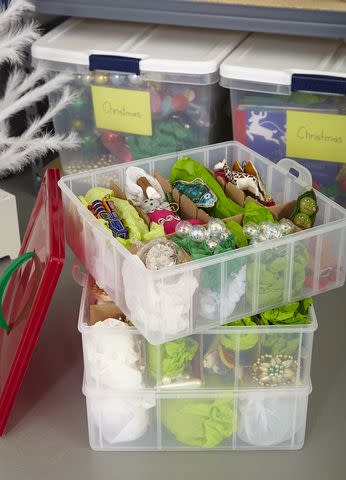10 Things You Should Never Store in the Attic
An out-of-sight, out-of-mind mentality might mean permanent damage to these particular items. Here’s where you should store them instead.

John Gruen
Having attic space certainly comes with its advantages. It allows you to tuck away items you don’t want cluttering up your living areas. However, hauling things upstairs with little to no intention can lead to a couple of problems.
For one, you might forget what’s actually in the attic and wind up rebuying something you already own. Secondly, items can easily be ruined in a space that tends to get overly hot and humid. Not only do you have heat, mold, and mildew to worry about, but pests are also a common problem in this lofted space.
If your attic is remodeled and climate controlled, you have more flexibility in what can be stored there. While you may be aware of some obvious no-gos, such as not to stash food upstairs, some of these things might surprise you. In addition to explaining why they shouldn’t be kept in the attic, you’ll get ideas for alternative storage solutions.
Related: Attic Storage Hacks to Help Make the Most of Your Space
Understand Your Attic
There are two main factors to consider when deciding what to store in the attic: high temperatures in the summertime and possible condensation during the winter.
Ideally, your attic shouldn’t be more than 10 to 20 degrees above the outside temperature. More realistically, however, they can go much higher than that (sometimes up to between 150 degrees Fahrenheit or more!), especially in warmer environments.
Direct sunlight can radiate through the roof as well creating a double whammy. It’s recommended to choose a lighter color for the roof next time you’re having it replaced. You can also use fans to increase circulation or, as the Department of Energy suggests for those living in exceptionally hot climates, install radiant barriers.
The second issue usually occurs more often during the colder months. Warm air from heating the home can rise into the attic and mix with cooler air under the roof. This causes moisture to develop that can turn to frost during the winter months. Once spring rolls around, the frost will melt and cause more condensation. While installing insulation in the attic helps warm the whole house and reduces heating bills, a poorly done job can also result in improper air circulation.
You’ll know if you’re experiencing either of these conditions by smelling a musty odor, seeing water droplets on a window, or feeling overly hot or cold when in the attic depending on the time of year. If you currently have things in the attic that show signs of mold and mildew, that’s another telltale sign. Remove them plus anything else on this list to help preserve your belongings.
1. Candles and Crayons
While it's unlikely you'll store these two items together, they fall under the same category. The wax that makes up both candles and crayons can melt in high heat and become a mess to clean up.
Instead, unused candles can be kept organized inside a cabinet or closet in a climate controlled room of the house. Collect extraneous crayons and contain them into bins in the playroom or craft room for the kids when they need to replace broken ones.
Related: How to Properly Store Candles to Make Them Last Longer
2. Books
Your beloved childhood collection, or those old textbooks from school, should never be stored in the attic for several reasons. High moisture levels can cause mold and mildew to quickly grow on the covers and pages in between. And, if that isn’t enough to deter you from stashing a box of them upstairs, this just might: Silverfish thrive in hot, humid environments and are known to feast on both paper and glue (such as the kind used in bindings). Discovering an infestation when you go to grab an old book would be an unwelcome experience, to say the least.
Channel your inner Marie Kondo and declutter the titles you’ll never read again before putting the keepers away on shelves in the living room or your home office. While you’re at it, steer clear of storing any paperwork, especially important documents, or photos in the attic to ensure they’re protected.
Related: Book Storage Ideas for All Your Favorite Literature
3. Instruments
Have you put a musical hobby aside for the time being? While you might plan to pick it up again in the future, don’t think about keeping your instruments in the attic until then. Mold and mildew can actually sneak their way inside them, putting your health at risk, specifically if it’s a wind instrument. Otherwise, those made of wood will warp in high heat and their cases, especially those with fabric interiors, are susceptible to mold, mildew, and insects.
What you should do instead is keep them in another location of the house that’s temperature controlled with low humidity. If you’re fortunate enough to have a bonus space, consider turning it into a music room or store them in their cases in an underused closet.
4. Fabric
As a general rule, all fabric should be excluded from attic storage. But pay special attention to anything compromised of wool, linen, and silk. Common attic critters, like moths, mice, and carpet beetles, are highly attracted to these materials. The aforementioned fibers, plus a slew of others including cotton and suede, are prone to mildewing if moisture is present. Leather clothing or furniture can begin to crack and take on a musty smell so leave it out as well. Along the same line, avoid using the attic to store excess rugs and bedding.
As tempting as it is toss off-season wardrobe pieces or future hand-me-downs in the attic, you’re better off finding a hiding spot on the main levels of the house. Stack labeled bins of clothes in a closet under the entryway stairs or slide a rug in the space under your bed. Use baskets or storage benches to house blankets and learn how to temporarily store a mattress.

Jay Wilde
5. Holiday and Home Decor
It’s fairly common to think of the attic as a good space to store holiday decorations once the season is over. After all, you won’t have to think about them again until next year so they can stay hidden away until then. Right? Well, considering that a lot of decor consists of materials like fabric and paper, it’s best to pick another place. The same goes for home accessories, particularly paintings that can fade or turn into a meal for pests and wood furnishings that will warp in high temperatures.
Consider donating decor that no longer suits your style and finding locations in the house to display the things you love. Keep decorations organized by holiday in labeled totes and store them on garage shelves or in the basement, especially if they’re more temperate conditions. If you’re not yet ready to part with your plethora of pieces, renting a climate-controlled storage unit may be a more fitting solution.
6. Keepsakes
Anything that’s irreplaceable, and therefore invaluable to you, is also off limits. This can include photos, as previously mentioned, as well as home videos, sentimental mementos, and family heirlooms or antiques. There’s simply too much at stake and the fluctuating temperatures and humidity levels in the attic create an unreliable storage space.
Use a bookshelf or TV cabinet to keep organized photos and videos so you can enjoy them whenever the mood strikes. Fill memory boxes with keepsakes such as cards and letters and place on a high shelf in a closet. Either work an heirloom into your current home design or ask a close relative if they would enjoy it more in their home instead.
Related: This Incredible Home Renovation Features Family Heirlooms and Vintage Treasures
7. Electronics and Batteries
Prolonged exposure to high temperatures can permanently damage electronics, rendering them defective. Heat can shorten battery life or cause them to rapidly corrode and potentially explode, creating a hazard.
Recycle old electronics at a local scrap metal facility and rehome the ones you utilize occasionally downstairs. Loose batteries can be organized into a junk drawer or utility closet where anyone in the family can find them.
Related: 15 Genius Ways to Organize Electronics, Games, and Media Items
8. Toxic or Flammable Substances
These items should be kept to a minimum in your home, but attics can be an especially dangerous place to store them. The fumes from chemicals emit gases into the air, which may seep into HVAC ducts and blow into the living spaces below. Additionally, fires are known to sweep through attic space rapidly as flames can spread up to the rafters and then down the walls of the entire house. While paint may seem somewhat harmless, some types such as oil-based or aerosol, can combust if they get too hot. On a lesser scale, the color and consistency may become ruined or the paint will likely dry out over time under the unstable attic conditions.
If possible, aim to keep all dangerous ingredients outside the house, such as in a shed or the garage, preferably a detached one. If leftover paint is stored properly, it can stay in the basement so long as it’s far away from any heat sources.
9. Fire Extinguishers
Now that you’ve removed any fire hazards from the attic, there’s no reason to stow an extinguisher in the space. But, even if you still felt the need, you might want to think twice. Most companies that manufacture these essential pieces of safety equipment warn that they are not designed to withstand temperatures above 120 degrees Fahrenheit. Which, if you recall, is possible for some attics to reach in peak summer months. The best-case scenario is that the heat will reduce the lifespan of the fire extinguisher. But the worst, albeit a very rare occurrence, is that it can explode.
Every home should have at least one extinguisher that perpetually lives in the kitchen, where most fires originate. It’s also smart to keep one on the second story and another in the laundry room in the event of a fire caused by a clogged dryer vent.
10. Heavy Items
Depending on the entryway to your attic, getting items in and out of it may be tricky. Make the process more painless by storing only lightweight things or containers up there. Moreover, overloading the area with heavy stuff can compromise the delicate attic floor.
In general, keeping the attic uncrowded and organized will help with air circulation. And always use plastic totes with latched lids when storing smaller items as opposed to boxes. Cardboard will begin to disintegrate when exposed to moisture and become home to uninvited, creepy-crawly guests.
Related: 13 Storage Mistakes You're Currently Making (and How to Fix Them)
For more Better Homes & Gardens news, make sure to sign up for our newsletter!
Read the original article on Better Homes & Gardens.

